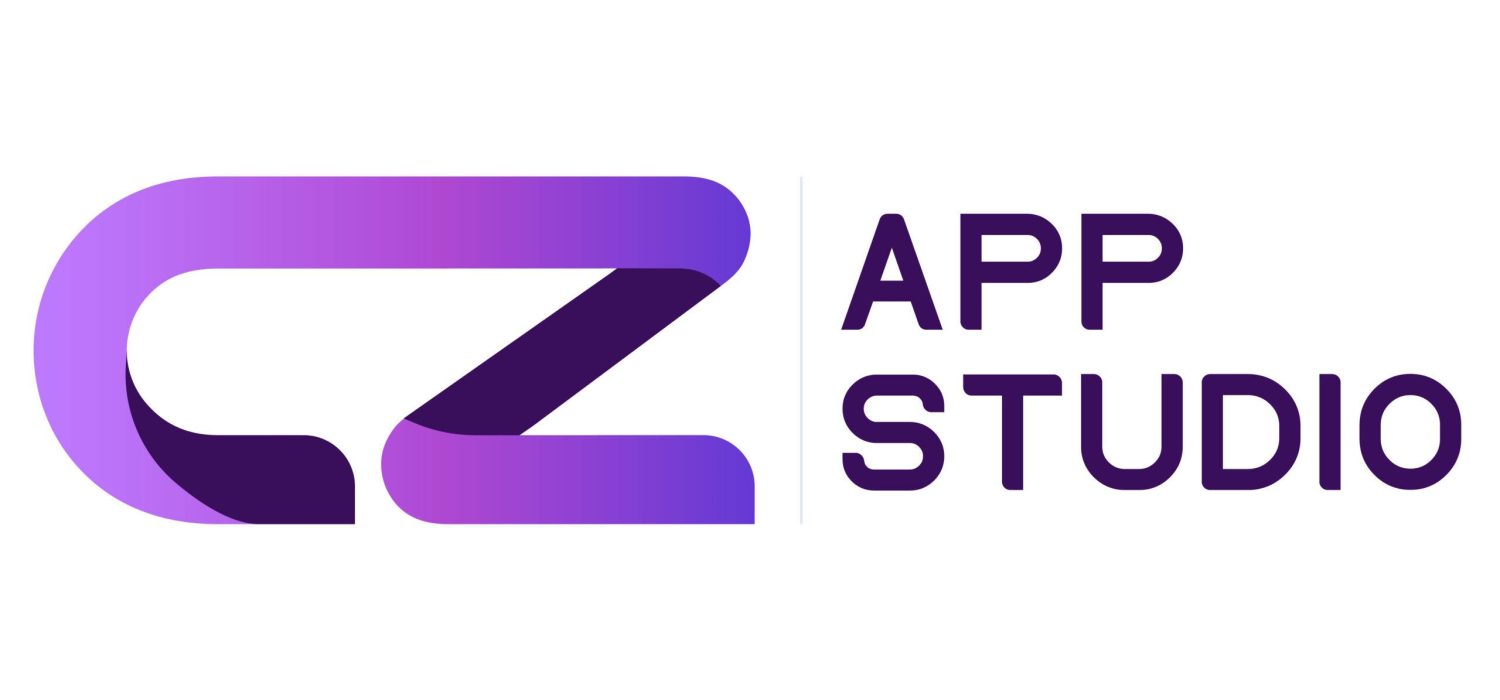Achieve More with Less: How Low-Code/No-Code is Revolutionizing Business Ops in 2025

The future of business? It’s not just about these huge tech companies anymore. It’s really about giving everyone the power to innovate, you know? Like, check out this awesome example from the no-code scene: Appy Pie shared a story about this up-and-coming entrepreneur in fashion. They actually used Appy Pie’s no-code tools to whip up a mobile-first e-commerce app in less than a month! And get this – it helped boost their online sales by a whopping 50% in just half a year. That just goes to show you how accessible and, honestly, how impactful these LCNC platforms are getting for genuine business growth in the real world.
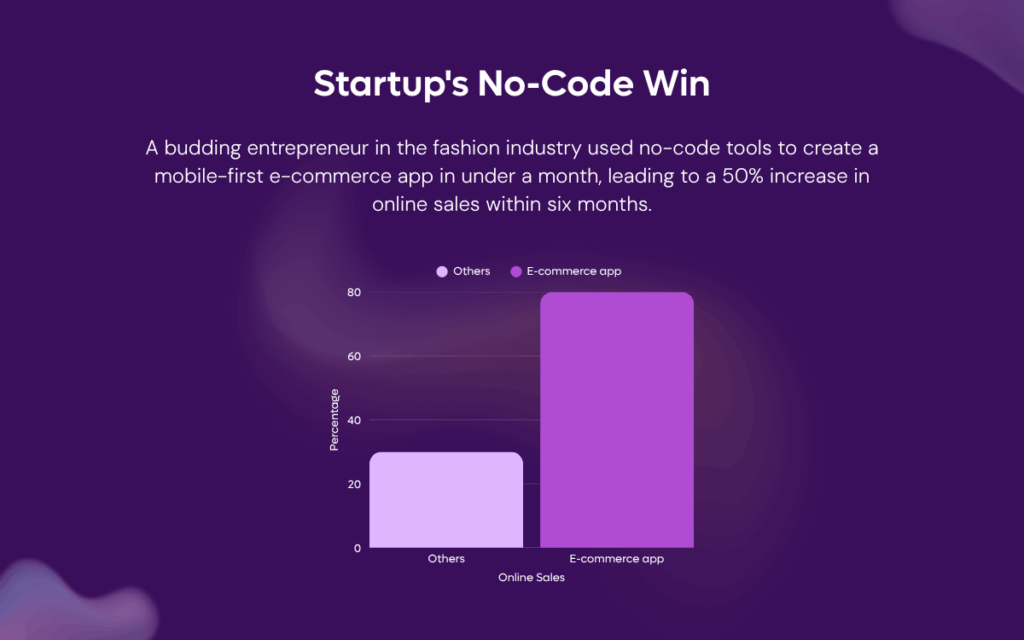
What Exactly is Low-Code/No-Code?
Imagine this: You’re able to build powerful software, launch dynamic websites, or even create custom apps for your business, all with little to zero coding knowledge. Sounds like a futuristic dream, right? Well, thanks to Low-Code/No-Code (LCNC) development platforms, it’s happening right now!
At its heart, LCNC is about empowering everyone – not just tech wizards – to create sophisticated digital solutions. These platforms, often delivered as Software as a Service (SaaS), give you an intuitive visual workspace. Think drag-and-drop interfaces, pre-built templates, and smart logic builders that let you “assemble” applications. What’s super cool is that behind the scenes, the platform automates all the complex coding, translating your visual actions into real, working software.
In 2025, LCNC is much more than just a buzzword. It’s truly taking off, driven by the massive demand for digital tools, a global shortage of traditional developers, and businesses desperately needing to move faster than ever.
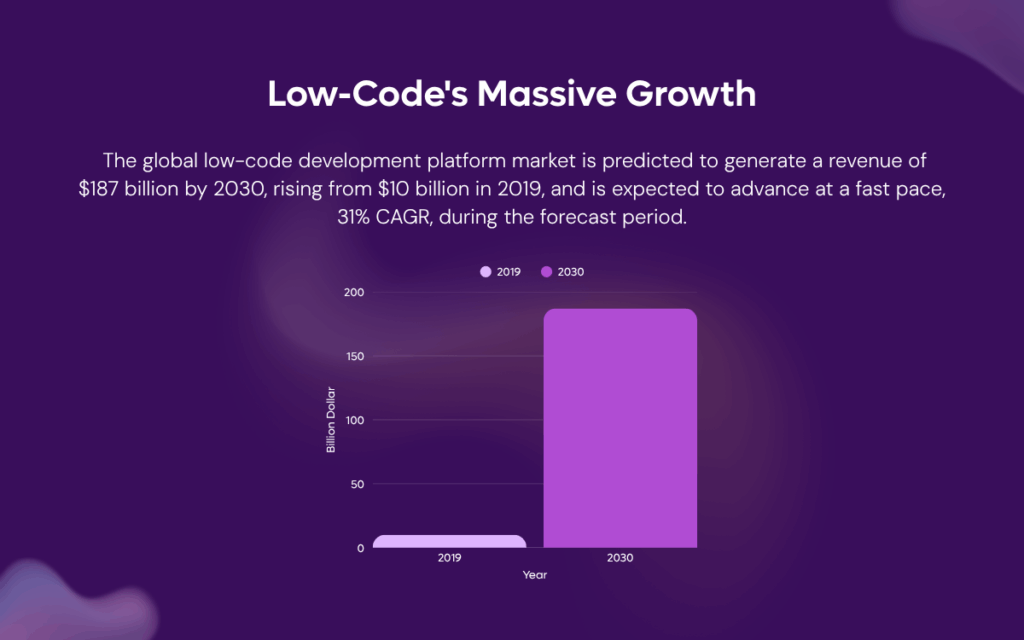
Source: GlobeNewswire
LCNC’s Real-World Impact
In 2025, Low-Code/No-Code isn’t just about promises; it’s delivering tangible results across all sorts of business operations. These powerful LCNC tools are helping companies do more with less, rapidly pushing digital projects forward and “future-proofing” their operations. Here’s where LCNC is making its biggest splash:
Building Web Apps Super Fast
LCNC platforms are making it incredibly quick to create internal tools, customer portals, unique CRMs, and highly interactive web applications. Businesses can build and deploy custom solutions that fit their exact needs without those super-long development cycles.
Examples: Bubble, Microsoft Power Platform
Simplified Mobile App Creation
You no longer need a huge team of developers to create functional mobile apps for specific business tasks, field teams, or customer engagement. LCNC makes it easy to rapidly prototype and launch mobile solutions.
Example: Adalo
Empowering E-commerce Platforms & Extensions
While not purely LCNC tools themselves, major e-commerce platforms like Shopify are adding powerful LCNC features for customization and integration. Merchants can build and personalize online stores, manage complex product catalogs, and extend capabilities through vast app marketplaces—often without touching a single line of code!
Example: Shopify
Intelligent Business Process Automation (BPA)
This is where No-Code truly shines! It’s all about connecting different systems and automating those repetitive, manual tasks across departments. From qualifying leads and updating inventory to setting up new employee onboarding, LCNC ensures smooth data flow and super efficient processes.
Example: Zapier
Custom Internal Tools & Database Management
Businesses are using LCNC to build custom dashboards, easy-to-use data entry systems, project management tools, and simplified interfaces for complex databases. These tailored solutions boost operational efficiency because they perfectly match what internal teams actually need.
Example: Microsoft Power Platform
Your LCNC Journey: A Simple To-Do List
Ready to dive into LCNC? Here’s a practical step-by-step guide:
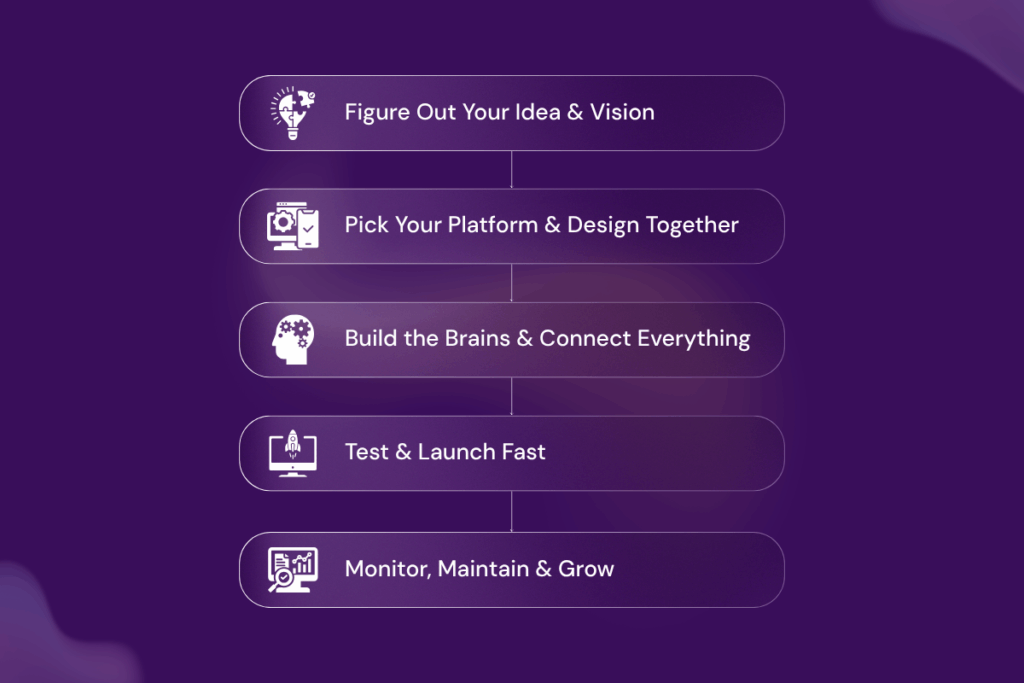
1. Figure Out Your Idea & Vision
Start by clearly identifying the specific problem you want to solve or the opportunity you want to grab. What’s the main goal of your app? What should it do? This becomes your basic blueprint.
2. Pick Your Platform & Design Together
Choose the LCNC platform that’s best for your project (web, mobile, or automation). Then, visually design the User Interface (UI) and User Experience (UX). Use templates and drag-and-drop elements. This visual approach naturally brings business users and IT together, making the design phase much quicker.
3. Build the Brains & Connect Everything
Now, you’ll assemble your software by setting up its logic, data rules, and business policies. A crucial part here is connecting your new app with other systems using built-in connectors or APIs. This ensures all your data flows seamlessly and processes are automated across your existing tech tools.
4. Test & Launch Fast
Thoroughly test your application to find and fix any bugs, making sure everything works as planned. The LCNC way supports quick changes based on feedback, so you can rapidly deploy and launch your working application.
5. Monitor, Maintain & Grow
After launching, keep an eye on how your app is performing, gather user feedback, and make continuous improvements. This ongoing process ensures your application keeps delivering value and supports your business’s growth, embodying the “continuous delivery” promise of LCNC.
Why LCNC Powers Your Business Ops?
Low-Code/No-Code isn’t just about cutting corners; it’s a smart strategic move that truly empowers your entire operation.
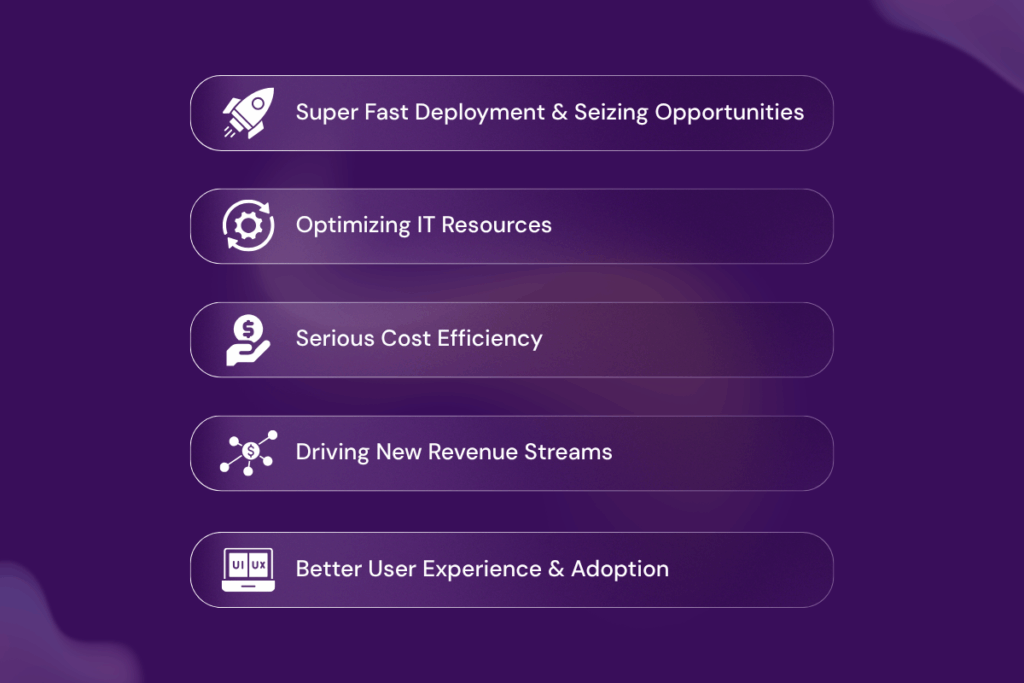
→ Super Fast Deployment & Seizing Opportunities:
Transform app development from months into mere weeks. This incredible speed means your business can quickly adapt and grab new market opportunities with unmatched agility.
→ Optimizing IT Resources (and Empowering Everyone Else!):
LCNC puts the power to build custom solutions directly into the hands of your business teams, greatly reducing their reliance on specialized coders. This frees up your IT department to tackle more strategic, complex projects.
→ Serious Cost Efficiency:
Expect a substantial drop in expenses related to large development teams, ongoing maintenance, and complex IT infrastructure. LCNC delivers sophisticated solutions at a fraction of what traditional development would cost.
→ Driving New Revenue Streams:
LCNC enables businesses to quickly launch new services, respond to market shifts, and meet customer demands more effectively. This directly leads to new and increased revenue opportunities.
→ Better User Experience & Adoption:
Enjoy highly intuitive and powerful user interfaces that are easy to access and built precisely for your team’s needs. This leads to faster user adoption and a big boost in productivity.
Navigating the LCNC Landscape
While incredibly powerful, embracing LCNC comes with a few things to consider for long-term success:

→ Platform Dependency:
Relying heavily on a specific LCNC platform can sometimes lead to “vendor lock-in,” potentially limiting your future flexibility or options if you ever need to move your solutions elsewhere.
→ Security & Governance:
The very ease of building apps means you need strong IT oversight. This ensures consistent data security, proper access control, and compliance across all the solutions you create.
→ Scalability Limitations:
While LCNC platforms are generally scalable, managing performance for extremely high-demand or super complex applications still requires careful planning.
→ Legacy Integration:
Connecting brand new LCNC solutions with older, deeply embedded legacy IT systems can often be more challenging than you might initially anticipate.
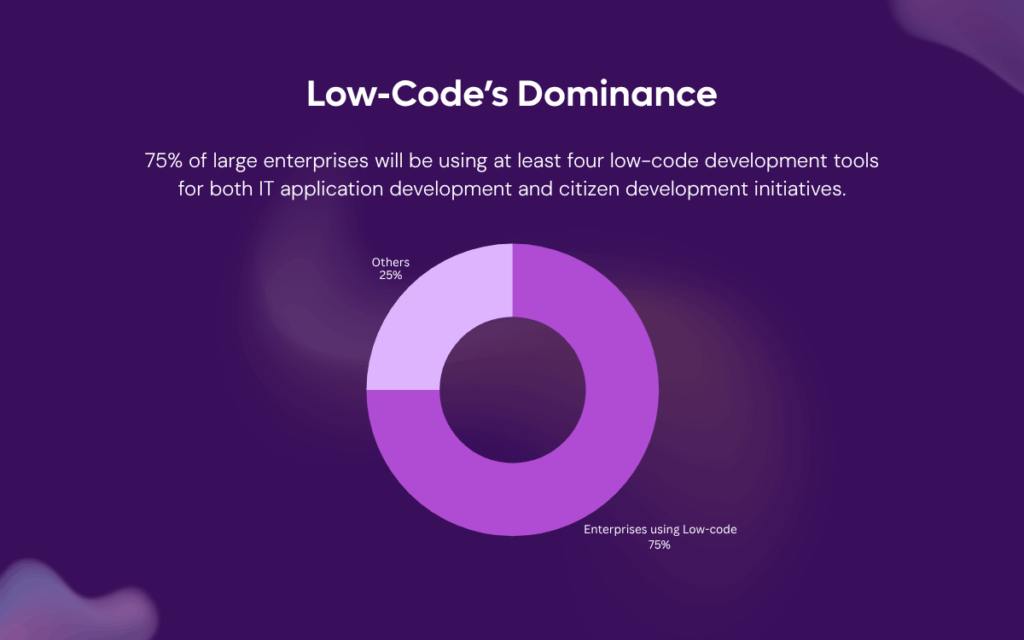
Source: Gartner
Conclusion: LCNC in 2025 – A True Game Changer
So, where does that leave us with Low-Code/No-Code in 2025? It’s crystal clear: this isn’t just tech hype; it’s a genuine revolution reshaping how businesses actually operate.
We’ve seen how these intuitive, visual platforms empower everyone, from the “citizen developer” (your non-IT colleagues!) to seasoned IT pros, letting them go from a brilliant idea to a real-world app in weeks, not months. It’s how you’re building web apps, mobile tools, and automating processes with unprecedented speed, saving serious cash, and ensuring your operations stay incredibly agile.
Of course, it’s not a magic wand – you’ll definitely want to be smart about platform choices, security, and making sure it plays nice with your existing systems. But by understanding these nuances, you’re not just creating apps; you’re equipping your entire business with the tools to innovate faster, achieve truly more with less, and remain relentlessly competitive.
- Field Staff Tracking for Small Businesses
 Managing field employees is one of the toughest parts of… Read more: Field Staff Tracking for Small Businesses
Managing field employees is one of the toughest parts of… Read more: Field Staff Tracking for Small Businesses - 2025: Why Lightweight Frameworks are the New Mandatory Engine of the Web
 Remember the early web, where every page felt clunky, especially… Read more: 2025: Why Lightweight Frameworks are the New Mandatory Engine of the Web
Remember the early web, where every page felt clunky, especially… Read more: 2025: Why Lightweight Frameworks are the New Mandatory Engine of the Web - Beyond Code: Why the Future of Technology Depends on Empathy
 Discover why empathy is becoming the most valuable factor in… Read more: Beyond Code: Why the Future of Technology Depends on Empathy
Discover why empathy is becoming the most valuable factor in… Read more: Beyond Code: Why the Future of Technology Depends on Empathy - 10 Proven Strategies to Maximize Your App Performance
 Flutter keeps evolving every year, and 2025 is no different.… Read more: 10 Proven Strategies to Maximize Your App Performance
Flutter keeps evolving every year, and 2025 is no different.… Read more: 10 Proven Strategies to Maximize Your App Performance - A Game Changer Attendance for Modern HRMS
 80% of success is showing up In today’s fast-moving world… Read more: A Game Changer Attendance for Modern HRMS
80% of success is showing up In today’s fast-moving world… Read more: A Game Changer Attendance for Modern HRMS
